Ecosystem Service Relationships, Drivers, and Regulation Strategies in a Degraded Alpine Shrub Meadow on the Northeastern Qinghai-Tibetan Plateau
Abstract
1. Introduction
2. Materials and Methods
2.1. Study Site
2.2. Field Sampling
2.2.1. Classification of Alpine Shrub Meadow Degradation Levels
2.2.2. Soil and Plant Sampling
2.3. Laboratory Analysis
2.3.1. Forage Supply
2.3.2. Water Retention
2.3.3. Influencing Factors
2.4. Ecosystem Service Relationship
2.4.1. Correlation Coefficient
2.4.2. Root Mean Square Error
2.4.3. Constraint Lines Extraction
2.5. Analysis of the Influencing Factors for Ecosystem Service Relationships
3. Results
3.1. Changes in the Water Retention and Forage Supply Services of Alpine Shrub Meadows at Different Degradation Levels
3.2. The Relationship between Water Retention and Forage Supply Services in the Alpine Shrub Meadow at Different Degradation Levels
3.3. Influencing Factors of the Ecosystem Service Relationship in the Alpine Shrub Meadow
4. Discussion
4.1. Characteristics and Influencing Factors of the Ecosystem Services Relationship in the Alpine Shrub Meadow
4.2. Managing Ecosystem Services in Alpine Shrub Meadows
5. Conclusions
Author Contributions
Funding
Institutional Review Board Statement
Informed Consent Statement
Data Availability Statement
Acknowledgments
Conflicts of Interest
References
- Millennium Ecosystem Assessment. Ecosystems and Human Well-Being: Synthesis: A Report of the Millennium Ecosystem Assessment; Island: Washington, DC, USA, 2005. [Google Scholar]
- Haines-Young, R.; Potschin, M. Proposal for a Common International Classification of Ecosystem Goods and Services (CICES) for Integrated Environmental and Economic Accounting; Department of Economic and Social Affairs, Statistics Division, United Nations: New York, NY, USA, 2010. [Google Scholar]
- Squires, V.R.; Dengler, J.; Hua, L.; Feng, H. Grasslands of the World: Diversity, Management and Conservation; CRC Press: Boca Raton, FL, USA, 2017. [Google Scholar]
- O’Mara, F.P. The role of grasslands in food security and climate change. Ann. Bot. 2012, 110, 1263–1270. [Google Scholar] [CrossRef] [PubMed]
- Bardgett, R.D.; Bullock, J.M.; Lavorel, S.; Manning, P.; Schaffner, U.; Ostle, N.; Chomel, M.; Durigan, G.; LFry, E.; Johnson, D.; et al. Combatting global grassland degradation. Nat. Rev. Earth Environ. 2021, 2, 720–735. [Google Scholar] [CrossRef]
- Gang, C.C.; Zhou, W.; Chen, Y.Z.; Wang, Z.Q.; Sun, Z.G.; Li, J.L.; Qi, J.G.; Odeh, I. Quantitative assessment of the contributions of climate change and human activities on global grassland degradation. Environ. Earth Sci. 2014, 72, 4273–4282. [Google Scholar] [CrossRef]
- Gibbs, H.K.; Salmon, J.M. Mapping the world’s degraded lands. Appl. Geogr. 2015, 57, 12–21. [Google Scholar] [CrossRef]
- Lark, T.J.; Spawn, S.A.; Bougie, M.; Gibbs, H.K. Cropland expansion in the United States produces marginal yields at high costs to wildlife. Nat. Commun. 2020, 11, 4295. [Google Scholar] [CrossRef]
- Bayer, W. Building resilience of human-natural systems of pastoralism in the developing world: Interdisciplinary perspectives. Rangel. J. 2017, 39, 401–403. [Google Scholar] [CrossRef]
- Bengtsson, J.; Bullock, J.M.; Egoh, B.; Everson, C.; Everson, T.; O’Connor, T.; O’Farrell, P.J.; Smith, H.G.; Lindborg, R. Grasslands-more important for ecosystem services than you might think. Ecosphere 2019, 10, 20. [Google Scholar] [CrossRef]
- Rodríguez, J.; Beard Jr, T.D.; Bennett, E.; Cumming, G.; Cork, S.; Agard, J.; Dobson, A.; Peterson, G. Trade-offs across space, time, and ecosystem services. Ecol. Soc. 2006, 11, 1–14. [Google Scholar] [CrossRef]
- Bennett, E.M.; Peterson, G.D.; Gordon, L.J. Understanding relationships among multiple ecosystem services. Ecol. Lett. 2009, 12, 1394–1404. [Google Scholar] [CrossRef]
- Zhang, Y.; Lu, X.; Liu, B.; Wu, D.; Fu, G.; Zhao, Y.; Sun, P. Spatial relationships between ecosystem services and socioecological drivers across a large-scale region: A case study in the Yellow River Basin. Sci. Total Environ. 2020, 766, 142480. [Google Scholar] [CrossRef]
- Pan, Y.; Wu, J.X.; Xu, Z.R. Analysis of the tradeoffs between provisioning and regulating services from the perspective of varied share of net primary production in an alpine grassland ecosystem. Ecol. Complex. 2014, 17, 79–86. [Google Scholar] [CrossRef]
- Petz, K.; Alkemade, R.; Bakkenes, M.; Schulp, C.J.E.; van der Velde, M.; Leemans, R. Mapping and modelling trade-offs and synergies between grazing intensity and ecosystem services in rangelands using global-scale datasets and models. Glob. Environ. Chang. 2014, 29, 223–234. [Google Scholar] [CrossRef]
- Khosravi Mashizi, A.; Heshmati, G.A.; Salman Mahini, A.R.; Escobedo, F.J. Exploring management objectives and ecosystem service trade-offs in a semi-arid rangeland basin in southeast Iran. Ecol. Indic. 2019, 98, 794–803. [Google Scholar] [CrossRef]
- Onatibia, G.R.; Aguiar, M.R.; Semmartin, M. Are there any trade-offs between forage provision and the ecosystem service of C and N storage in arid rangelands? Ecol. Eng. 2015, 77, 26–32. [Google Scholar] [CrossRef]
- Wu, J.X.; Zhao, Y.; Yu, C.Q.; Luo, L.M.; Pan, Y. Land management influences trade-offs and the total supply of ecosystem services in alpine grassland in Tibet, China. J. Environ. Manag. 2017, 193, 70–78. [Google Scholar] [CrossRef] [PubMed]
- Fan, F.; Liang, C.Z.; Tang, Y.K.; Harker-Schuch, I.; Porter, J.R. Effects and relationships of grazing intensity on multiple ecosystem services in the Inner Mongolian steppe. Sci. Total Environ. 2019, 675, 642–650. [Google Scholar] [CrossRef]
- Xu, Y.D.; Dong, S.K.; Gao, X.X.; Yang, M.Y.; Li, S.; Shen, H.; Xiao, J.N.; Han, Y.H.; Zhang, J.; Li, Y.; et al. Trade-offs and cost-benefit of ecosystem services of revegetated degraded alpine meadows over time on the Qinghai-Tibetan Plateau. Agric. Ecosyst. Environ. 2019, 279, 130–138. [Google Scholar] [CrossRef]
- Li, M.; Li, X.; Liu, S.; Li, X.; Lyu, X.; Dang, D.; Dou, H. Ecosystem services under different grazing intensities in typical grasslands in Inner Mongolia and their relationships. Glob. Ecol. Conserv. 2021, 26, e01526. [Google Scholar] [CrossRef]
- Dong, S.K.; Sherman, R. Enhancing the resilience of coupled human and natural systems of alpine rangelands on the Qinghai-Tibetan Plateau. Rangel. J. 2015, 37, i-iii. [Google Scholar] [CrossRef]
- Cao, J.; Adamowski, J.F.; Deo, R.C.; Xu, X.; Gong, Y.; Feng, Q. Grassland Degradation on the Qinghai-Tibetan Plateau: Reevaluation of Causative Factors. Rangel. Ecol. Manag. 2019, 72, 988–995. [Google Scholar] [CrossRef]
- Yashiro, Y.; Shizu, Y.; Hirota, M.; Shimono, A.; Ohtsuka, T. The role of shrub (Potentilla fruticosa) on ecosystem CO2 fluxes in an alpine shrub meadow. J. Plant Ecol. 2010, 3, 89–97. [Google Scholar] [CrossRef]
- Li, H.Q.; Zhang, F.W.; Li, Y.N.; Wang, J.B.; Zhang, L.M.; Zhao, L.; Cao, G.M.; Zhao, X.Q.; Du, M.Y. Seasonal and inter-annual variations in CO2 fluxes over 10 years in an alpine shrubland on the Qinghai-Tibetan Plateau, China. Agric. For. Meteorol. 2016, 228, 95–103. [Google Scholar] [CrossRef]
- Dai, L.; Guo, X.; Ke, X.; Du, Y.; Zhang, F.; Cao, G. The variation in soil water retention of alpine shrub meadow under different degrees of degradation on northeastern Qinghai-Tibetan plateau. Plant Soil. 2020, 458, 231–244. [Google Scholar] [CrossRef]
- Li, S.; Li, X.; Dou, H.; Dang, D.; Gong, J. Integrating constraint effects among ecosystem services and drivers on seasonal scales into management practices. Ecol. Indic. 2021, 125, 107425. [Google Scholar] [CrossRef]
- Horning, M. Constraint lines and performance envelopes in behavioral physiology: The case of the aerobic dive limit. Front Physiol. 2012, 3, 381. [Google Scholar] [CrossRef] [PubMed]
- Mills, A.J.; Fey, M.V.; Grongroft, A.; Petersen, A.; Medinski, T.V. Unravelling the effects of soil properties on water infiltration: Segmented quantile regression on a large data set from arid south-west Africa. Aust. J. Soil Res. 2006, 44, 783–797. [Google Scholar] [CrossRef]
- Jiang, C.; Wang, X.C.; Zhang, H.Y.; Labzovskii, L.; Wang, J.; Liu, T. Re-orienting ecological restoration in degraded drylands for a more sustainable soil-water relationship: Non-linear boundary of limited water resources in combating soil loss. J. Arid Environ. 2019, 167, 87–100. [Google Scholar] [CrossRef]
- Qiao, J.; Yu, D.; Cao, Q.; Hao, R. Identifying the relationships and drivers of agro-ecosystem services using a constraint line approach in the agro-pastoral transitional zone of China. Ecol. Indic. 2019, 106, 105439. [Google Scholar] [CrossRef]
- Dade, M.C.; Mitchell, M.G.E.; McAlpine, C.A.; Rhodes, J.R. Assessing ecosystem service trade-offs and synergies: The need for a more mechanistic approach. Ambio 2019, 48, 1116–1128. [Google Scholar] [CrossRef]
- Obiang Ndong, G.; Therond, O.; Cousin, I. Analysis of relationships between ecosystem services: A generic classification and review of the literature. Ecosyst. Serv. 2020, 43, 101120. [Google Scholar] [CrossRef]
- Cao, G.; Du, Y.; Liang, D.; Wang, Q.; Wang, C. Character of passive-active degradation process and its mechanism in alpine kobresia meadow. J. Mt. Sci. Engl. 2007, 25, 641–648. [Google Scholar]
- Dai, L.; Guo, X.; Ke, X.; Du, Y.; Zhang, F.; Li, Y.; Li, Q.; Lin, L.; Cao, G.; Peng, C.; et al. The response of Potentilla fruticosa communities to degradation succession in Qinghai-Tibet plateau. Ecol. Environ. Sci. 2019, 28, 732–740. [Google Scholar] [CrossRef]
- Zhang, F.; Zeng, C.; Zhang, Q.; Yao, T. Securing water quality of the Asian Water Tower. Nat. Rev. Earth Environ. 2022, 3, 611–612. [Google Scholar] [CrossRef]
- Jiao, F.; Wen, Z.M.; An, S.S. Changes in soil properties across a chronosequence of vegetation restoration on the Loess Plateau of China. Catena 2011, 86, 110–116. [Google Scholar] [CrossRef]
- Cui, Z.; Liu, Y.; Huang, Z.; He, H.H.; Wu, G.L. Potential of artificial grasslands in crop rotation for improving farmland soil quality. Land Degrad. Dev. 2019, 30, 2187–2196. [Google Scholar] [CrossRef]
- Cao, G.; Zhang, F. China Ecosystem Positioning Observation and Research Dataset: Grassland and Desert Ecosystem Volume, Qinghai Haibei Station; China Agriculture Press: Beijing, China, 2021. [Google Scholar]
- Xie, H.T.; Yang, X.M.; Drury, C.F.; Yang, J.Y.; Zhang, X.D. Predicting soil organic carbon and total nitrogen using mid- and near-infrared spectra for Brookston clay loam soil in Southwestern Ontario, Canada. Can. J. Soil Sci. 2011, 91, 53–63. [Google Scholar] [CrossRef]
- Fu, B.J.; Liu, S.L.; Chen, L.D.; Lu, Y.H.; Qiu, J. Soil quality regime in relation to land cover and slope position across a highly modified slope landscape. Ecol. Res. 2004, 19, 111–118. [Google Scholar] [CrossRef]
- Nelson, D.W.; Sommers, L.E. Total Carbon, Organic Carbon, and Organic Matter. Methods Soil Anal. 1996, 5, 961–1010. [Google Scholar]
- Bradford, J.B.; D’Amato, A.W. Recognizing trade-offs in multi-objective land management. Front. Ecol. Environ. 2012, 10, 210–216. [Google Scholar] [CrossRef]
- Deng, L.; Wang, K.B.; Li, J.P.; Zhao, G.W.; Shangguan, Z. Effect of soil moisture and atmospheric humidity on both plant productivity and diversity of native grasslands across the Loess Plateau, China. Ecol. Eng. 2016, 94, 525–531. [Google Scholar] [CrossRef]
- Hao, H.M.; Lu, R.; Liu, Y.; Fang, N.F.; Wu, G.L.; Shi, Z.H. Effects of shrub patch size succession on plant diversity and soil water content in the water-wind erosion crisscross region on the Loess Plateau. Catena 2016, 144, 177–183. [Google Scholar] [CrossRef]
- Yang, Y.; Dou, Y.X.; An, S.S.; Zhu, Z.L. Abiotic and biotic factors modulate plant biomass and root/shoot (R/S) ratios in grassland on the Loess Plateau, China. Sci. Total Environ. 2018, 636, 621–631. [Google Scholar] [CrossRef] [PubMed]
- Breidenbach, A.; Schleuss, P.M.; Liu, S.B.; Schneider, D.; Dippold, M.A.; de la Haye, T.; Miehe, G.; Heitkamp, F.; Seeber, E.; Mason-Jones, K.; et al. Microbial functional changes mark irreversible course of Tibetan grassland degradation. Nat. Commun. 2022, 13, 2681. [Google Scholar] [CrossRef] [PubMed]
- Yang, F.; Zhang, G.-L.; Yang, J.-L.; Li, D.-C.; Zhao, Y.-G.; Liu, F.; Yang, R.-M.; Yang, F. Organic matter controls of soil water retention in an alpine grassland and its significance for hydrological processes. J. Hydrol. 2014, 519, 3086–3093. [Google Scholar] [CrossRef]
- Kerr, D.D.; Ochsner, T.E. Soil organic carbon more strongly related to soil moisture than soil temperature in temperate grasslands. Soil Sci. Soc. Am. J. 2020, 84, 587–596. [Google Scholar] [CrossRef]
- Chen, W.; Wolf, B.; Zheng, X.; Yao, Z.; Butterbach-Bahl, K.; Brüggemann, N.; Liu, C.; Han, S.; Han, X. Annual methane uptake by temperate semiarid steppes as regulated by stocking rates, aboveground plant biomass and topsoil air permeability. Global Chang. Biol. 2011, 17, 2803–2816. [Google Scholar] [CrossRef]
- Tian, D.; Niu, S.; Pan, Q.; Ren, T.; Chen, S.; Bai, Y.; Han, X. Nonlinear responses of ecosystem carbon fluxes and water-use efficiency to nitrogen addition in Inner Mongolia grassland. Funct. Ecol. 2016, 30, 490–499. [Google Scholar] [CrossRef]
- You, Q.; Xue, X.; Peng, F.; Dong, S.; Gao, Y. Surface water and heat exchange comparison between alpine meadow and bare land in a permafrost region of the Tibetan Plateau. Agric. For. Meteorol. 2017, 232, 48–65. [Google Scholar] [CrossRef]
- Hao, R.F.; Yu, D.Y.; Wu, J.G. Relationship between paired ecosystem services in the grassland and agro-pastoral transitional zone of China using the constraint line method. Agric. Ecosyst. Environ. 2017, 240, 171–181. [Google Scholar] [CrossRef]
- Geroy, I.J.; Gribb, M.M.; Marshall, H.P.; Chandler, D.G.; Benner, S.G.; McNamara, J.P. Aspect influences on soil water retention and storage. Hydrol. Process. 2011, 25, 3836–3842. [Google Scholar] [CrossRef]
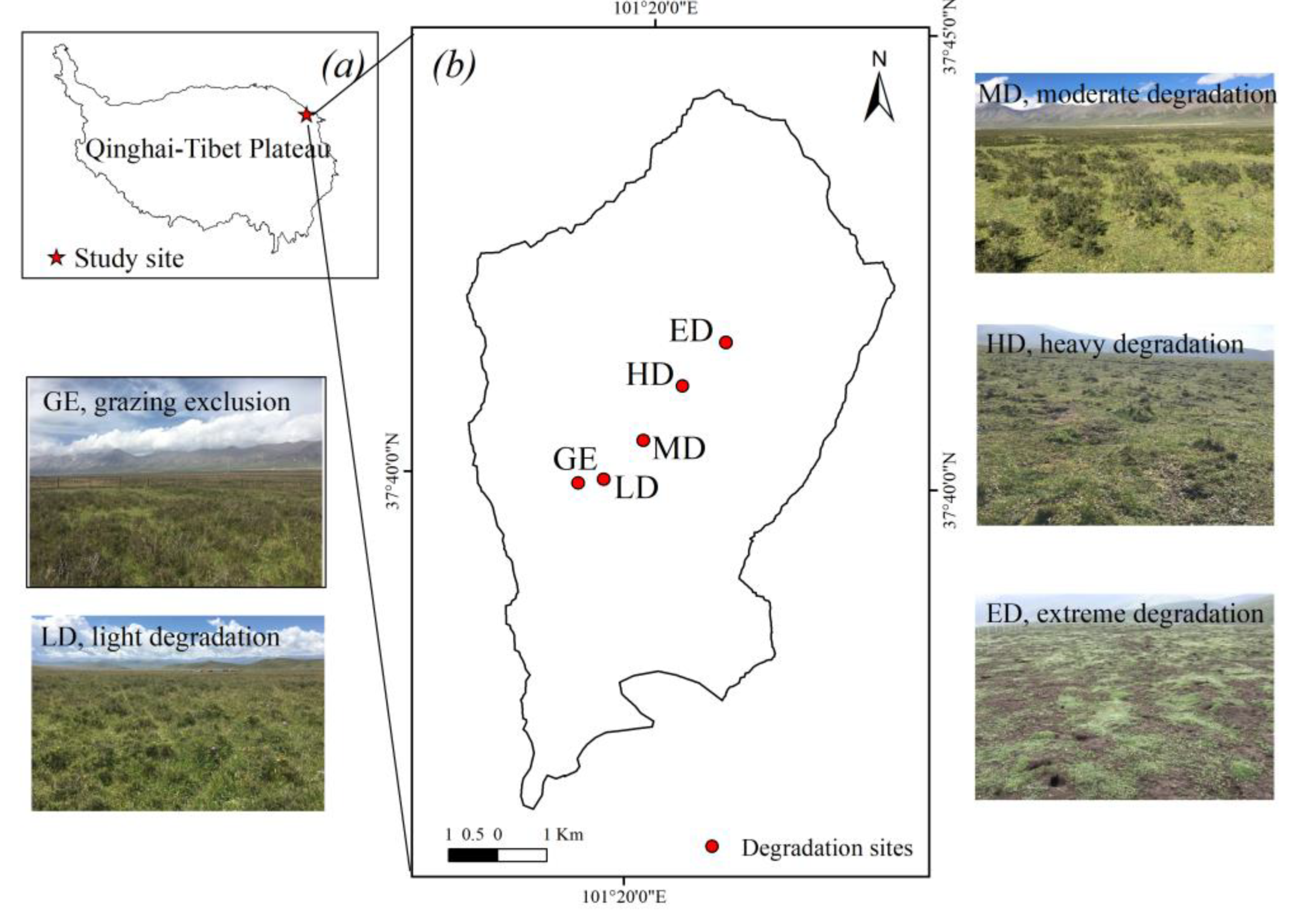
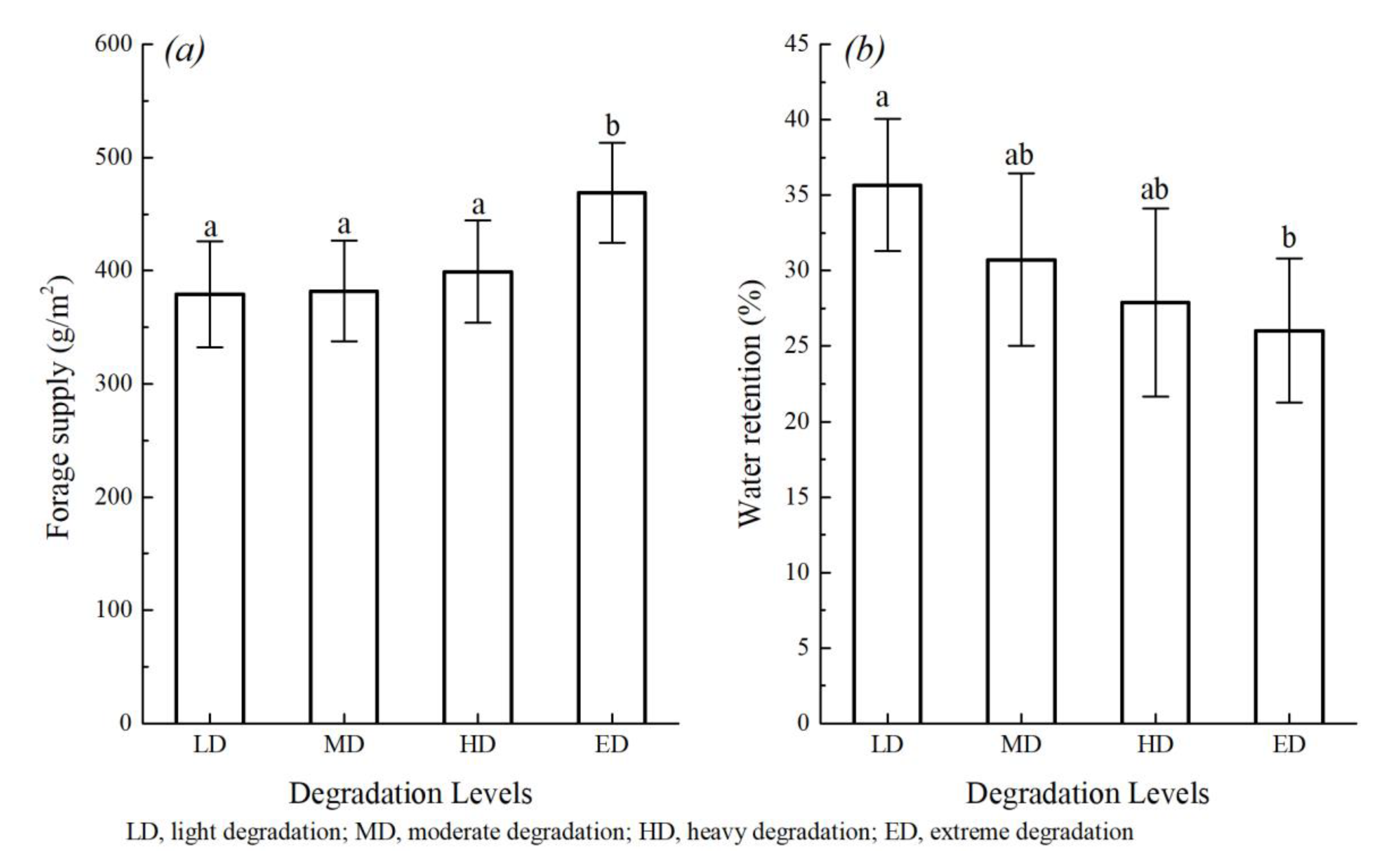
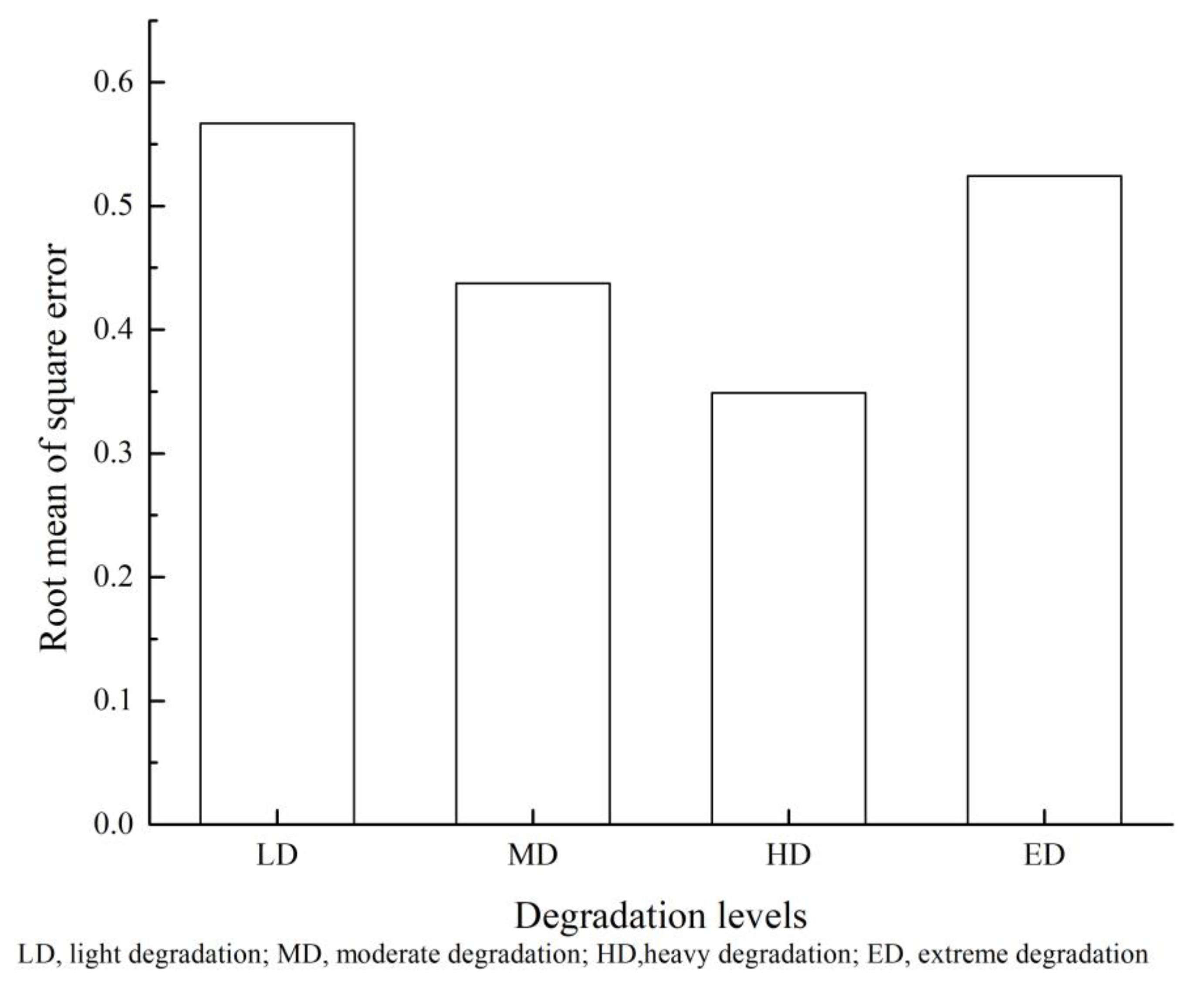

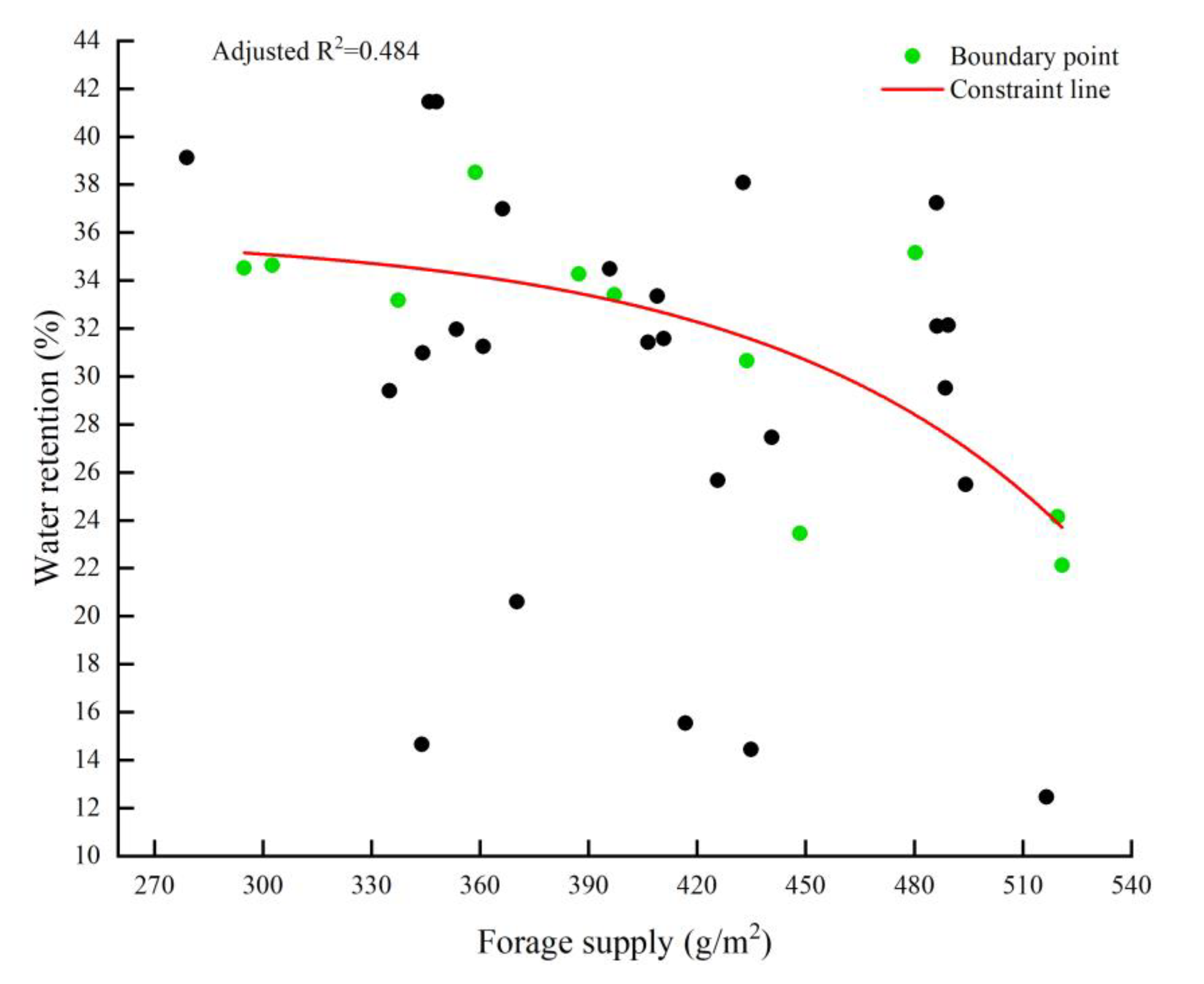
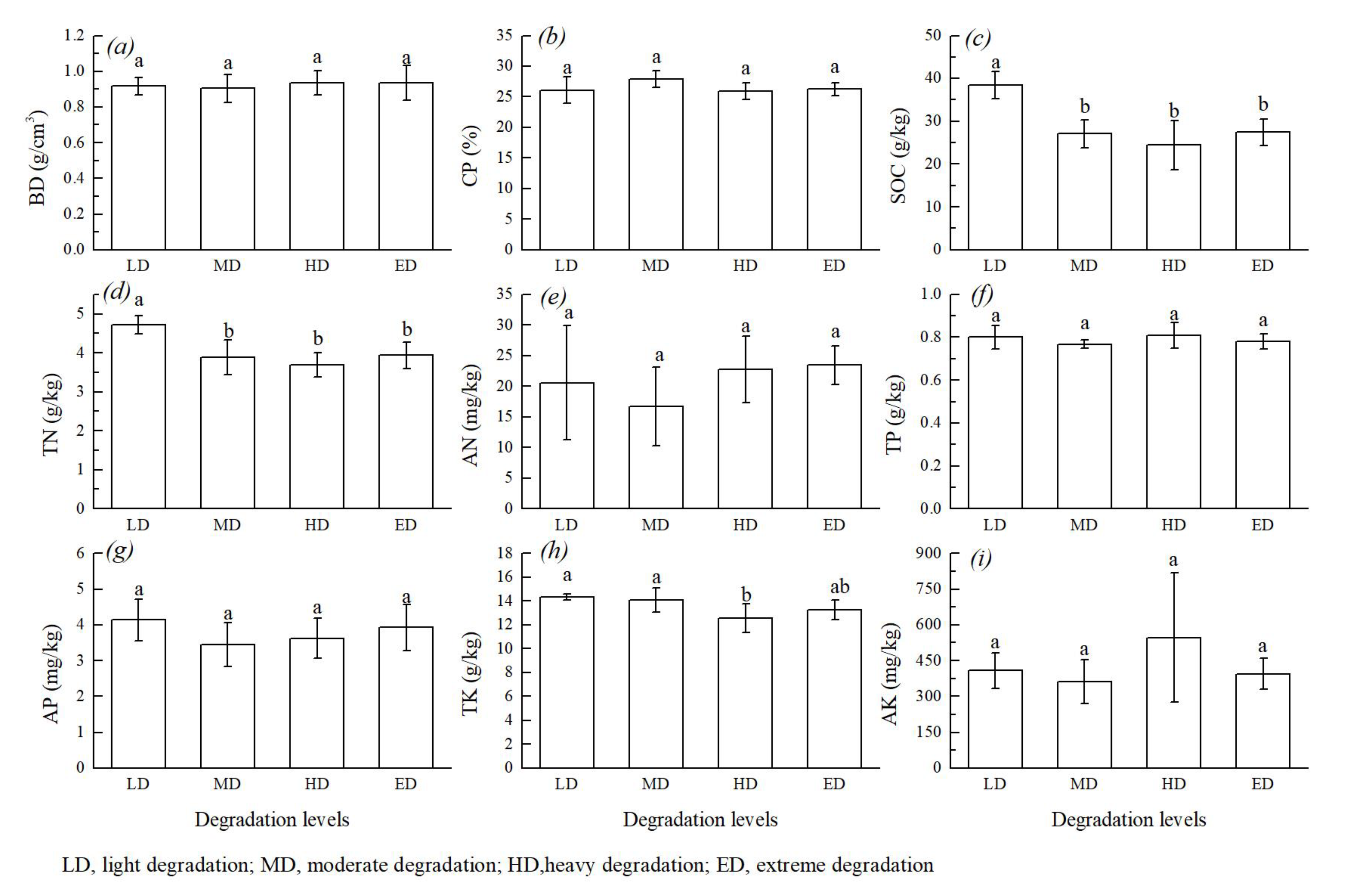

| Degradation Level | Shrub Coverage (%) | Species Number |
|---|---|---|
| LD | 50–60 | 24 |
| MD | 40–50 | 22 |
| HD | 5–10 | 26 |
| ED | 0 | 14 |
| Model | Unstandardized Coefficients | Sig. | |
|---|---|---|---|
| B | Standard error | ||
| Constants | 25.032 | 5.018 | 0.000 |
| AK | −0.015 | 0.006 | 0.010 |
| SOC | 0.393 | 0.153 | 0.015 |
Disclaimer/Publisher’s Note: The statements, opinions and data contained in all publications are solely those of the individual author(s) and contributor(s) and not of MDPI and/or the editor(s). MDPI and/or the editor(s) disclaim responsibility for any injury to people or property resulting from any ideas, methods, instructions or products referred to in the content. |
© 2023 by the authors. Licensee MDPI, Basel, Switzerland. This article is an open access article distributed under the terms and conditions of the Creative Commons Attribution (CC BY) license (https://creativecommons.org/licenses/by/4.0/).
Share and Cite
Qian, D.; Fan, B.; Lan, Y.; Si, M.; Li, Q.; Guo, X. Ecosystem Service Relationships, Drivers, and Regulation Strategies in a Degraded Alpine Shrub Meadow on the Northeastern Qinghai-Tibetan Plateau. Diversity 2023, 15, 596. https://doi.org/10.3390/d15050596
Qian D, Fan B, Lan Y, Si M, Li Q, Guo X. Ecosystem Service Relationships, Drivers, and Regulation Strategies in a Degraded Alpine Shrub Meadow on the Northeastern Qinghai-Tibetan Plateau. Diversity. 2023; 15(5):596. https://doi.org/10.3390/d15050596
Chicago/Turabian StyleQian, Dawen, Bo Fan, Yuting Lan, Mengke Si, Qian Li, and Xiaowei Guo. 2023. "Ecosystem Service Relationships, Drivers, and Regulation Strategies in a Degraded Alpine Shrub Meadow on the Northeastern Qinghai-Tibetan Plateau" Diversity 15, no. 5: 596. https://doi.org/10.3390/d15050596
APA StyleQian, D., Fan, B., Lan, Y., Si, M., Li, Q., & Guo, X. (2023). Ecosystem Service Relationships, Drivers, and Regulation Strategies in a Degraded Alpine Shrub Meadow on the Northeastern Qinghai-Tibetan Plateau. Diversity, 15(5), 596. https://doi.org/10.3390/d15050596







